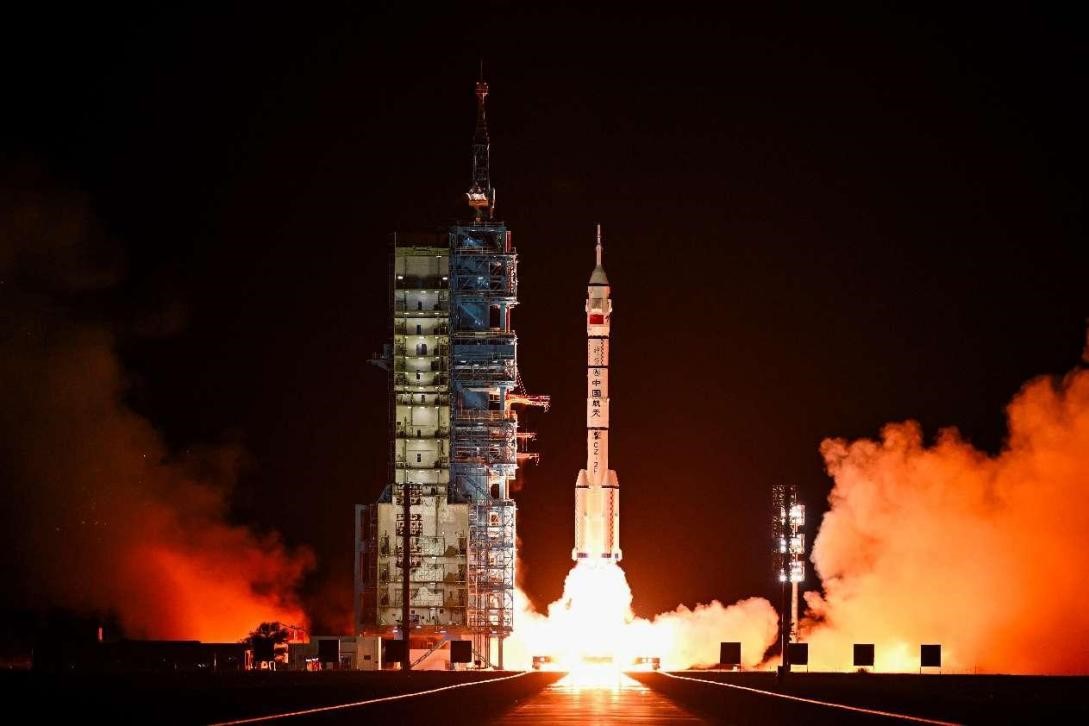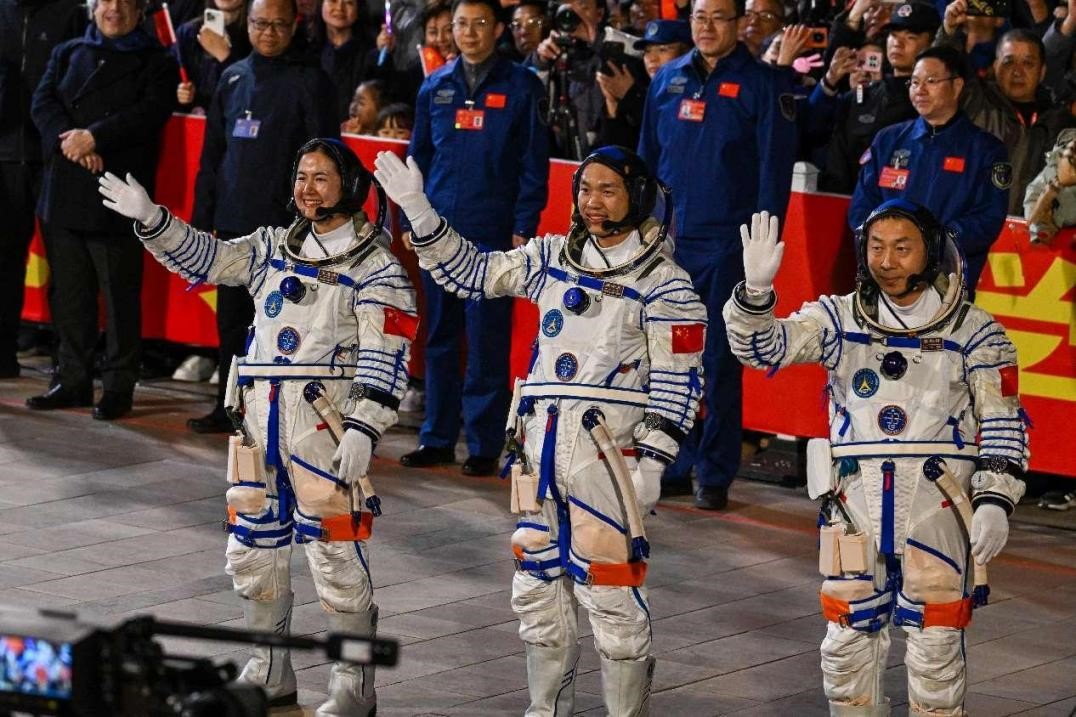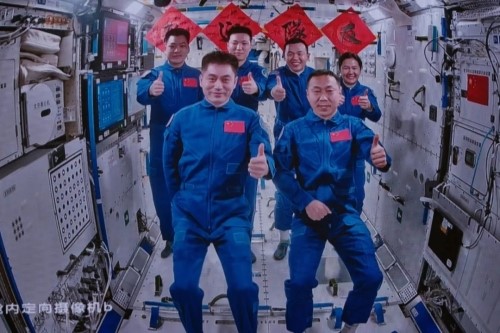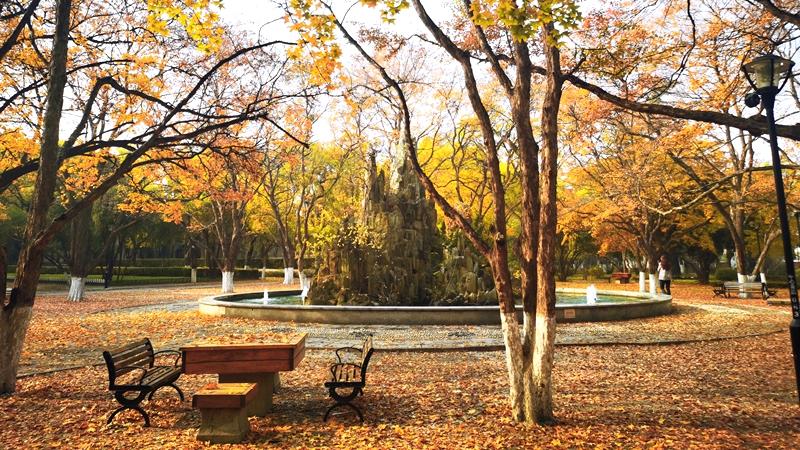Shenzhou-19 crew to reside on space station for six months
At 4:27 a.m. Beijing time on Oct. 30, a dazzling beam of light illuminated the pitch-black night sky. The Shenzhou-19 crewed spaceship, atop a Long March-2F carrier rocket, took off from the Jiuquan Satellite Launch Center in northwest China and headed towards the Chinese space station.
At 12:51 p.m. on Oct. 30, the Shenzhou-19 crew successfully joined the Shenzhou-18 crew in the space station. After finishing handover, the crew of China's Shenzhou-18 spacecraft returned to the Dongfeng landing site in north China's Inner Mongolia Autonomous Region on Nov. 4.
Cai Xuzhe, born in the 1970s, serves as the commander of the Shenzhou-19 crew. It is the first time for him to be in this position. With this ongoing mission, he set a new record for the shortest interval between two spaceflights for Chinese astronauts.

At 4:27 a.m. on Oct. 30, the Shenzhou-19 manned spacecraft, atop a Long March-2F carrier rocket, blasts off from the Jiuquan Satellite Launch Center in northwest China. (People's Daily Online/Wang Xiaobo)
Crew members Song Lingdong and Wang Haoze, both born in the 1990s, are on their first spaceflight mission. Prior to being selected, Wang was a senior engineer at the Academy of Aerospace Propulsion Technology, China Aerospace Science and Technology Corporation. She is China's only female space flight engineer and the third Chinese woman to participate in a crewed spaceflight mission.
The Shenzhou-19 mission marks the fourth crewed flight in the application and development phase of China's space station and the 33rd flight of China's manned space program.
Its primary goals are to complete an in-orbit crew rotation with the Shenzhou-18 crew, reside on the space station for about half a year, conduct space science and application experiments, perform extravehicular activities (EVAs), manage cargo entry and exit, install and recover space debris protection devices and other external equipment on the space station, and engage in science education, public welfare activities, and other payload tests. The aim is to further improve the operation efficiency of the space station and maximize the comprehensive benefits of its applications.
It is reported that the Shenzhou-19 mission will carry out 86 space science research and technology experiments, covering various fields including space life science, microgravity fundamental physics, space material science, space medicine and new space technologies.
The Shenzhou-19 crew will conduct structural analysis of protein crystal growth and non-equilibrium dynamics of soft matter under microgravity conditions.
The astronauts are expected to advance frontier research into basic theories, the development of new materials, the physiological effect mechanism of space radiation and weightlessness, hypomagnetic biological effects and molecular mechanisms.

A see-off ceremony for three Chinese astronauts of the Shenzhou-19 crewed space mission is held, Oct. 30. (People's Daily Online/Wang Xiaobo)
A report on the scientific research and application development of the space station Tiangong is slated for release on the second anniversary of its completion, to introduce the representative results achieved by the space station since it was sent to orbit.
According to Lin Xiqiang, spokesperson for the China Manned Space Agency, the selection of the fourth-batch Chinese astronauts concluded in May this year. Ten astronaut candidates made to the final list, including eight space pilots and two payload experts. Their training started this August.
The fourth-batch Chinese astronauts will not only perform tasks related to the space station, but also prepare for future manned lunar missions. Therefore, their training subjects emphasize essential skills such as living, working and maintaining health in a weightless environment. They will also master specialized skills including EVAs, equipment maintenance, and space science experiments.
Besides, they will develop capabilities in spacecraft operation, lunar rover driving, celestial navigation, geological fieldwork, as well as adapting from weightlessness in space to walking with loads on the lunar surface.
China is pressing ahead with its mission to land astronauts on the Moon by 2030, moving quickly with development and construction to turn this goal into reality.
The production and ground tests of prototypes of the Long March-10 carrier rocket, the manned spacecraft Mengzhou, the lunar lander Lanyue, the spacesuit to be worn by astronauts and the manned lunar rover are underway as planned.

The crew of Shenzhou-18 and Shenzhou-19 manned spaceships pose for a photo in China's space station, Oct. 30. (Photo/Li Jie)
A series of major tests have been completed, including the integrated airdrop test for the spacecraft, and the separation test for the two modules of the lander.
The overall plan for pre-launch flight tests as well as the scientific research objectives and payloads for the first manned lunar mission has been basically determined. The development and construction of systems such as launch sites, telemetry and communication, and landing sites are progressing in an orderly manner as planned.
Lin said that currently, the first batch of payloads selected under cooperation between China and the United Nations Office for Outer Space Affairs are conducting experiments in orbit. Simultaneously, efforts are being made with relevant countries to promote the implementation of more joint experimental research, consultations, selection and training of astronauts to participate in flights to the Chinese space station.
Lin said the China's space station serves not only as a national asset but also as a platform for advancing space technology and bringing benefits to all of humanity. The world is always welcome to participate in flight missions of the Chinese space station.
Photos
Related Stories
- Shenzhou-18 mission returns samples for extraterrestrial habitation research
- Shenzhou-18 astronauts arrive in Beijing
- Chinese astronauts return to Earth safely, experiencing busy, joyful space life
- China's Shenzhou-18 astronauts complete handover, returning to Earth on Monday
- Dongfeng landing site ready to welcome return of Shenzhou-18 astronauts
Copyright © 2024 People's Daily Online. All Rights Reserved.









